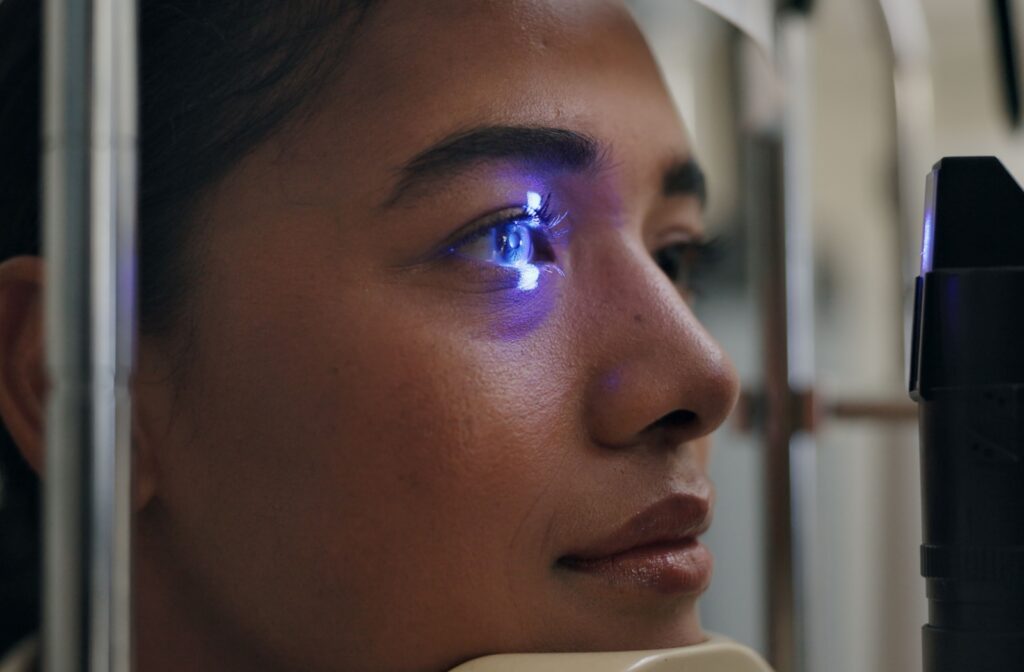Experiencing sudden blackouts in your vision can be alarming. These episodes can range from brief moments of darkness to longer periods where vision is completely obscured.
There are various reasons why your vision may go black randomly, including:
- Orthostatic hypotension
- Migraine auras
- Transient ischemic attacks
- Retinal detachment
- Glaucoma
- Vasovagal syncope
Understanding the underlying causes and knowing when to seek medical attention is crucial for maintaining eye health and overall well-being. Start by seeking out an emergency eye exam!
Common Causes of Sudden Vision Blackouts
Orthostatic Hypotension
This condition occurs when there is a sudden drop in blood pressure upon standing up quickly. The reduced blood flow to the brain can cause temporary vision blackouts.
Symptoms can include dizziness, lightheadedness, and fainting. Prevention is simple–stand up slowly, stay hydrated, and avoid prolonged periods of sitting or lying down.
Migraine Auras
Migraines can sometimes be preceded by visual disturbances known as auras. These can include temporary vision loss or blackouts.
Symptoms often include flashing lights, zigzag patterns, and blind spots.
Transient Ischemic Attack (TIA)
Often referred to as a “mini-stroke,” a TIA is caused by a temporary lack of blood flow to the brain. This can result in sudden vision loss or blackouts.
Symptoms include sudden weakness, numbness, difficulty speaking, and loss of balance. Seek immediate medical attention if experiencing a transient ischemic attack, as TIAs can be a warning sign of a future stroke.
Retinal Detachment
This serious condition occurs when the retina detaches from the back of the eye, leading to sudden vision loss.
Symptoms include the sudden appearance of floaters, flashes of light, and a shadow or curtain over part of the visual field. Immediate medical intervention is required to prevent permanent vision loss.
Glaucoma
Glaucoma is a group of eye conditions that damage the optic nerve, often due to high intraocular pressure (IOP). Acute angle-closure glaucoma can cause sudden vision blackouts.
Symptoms often include severe eye pain, headache, nausea, and blurred vision.
Vasovagal Syncope
This common cause of fainting occurs when the body overreacts to certain triggers, such as the sight of blood or extreme emotional distress.
Symptoms include lightheadedness, nausea, and sudden vision blackouts.

When to Seek Medical Attention
While some causes of sudden vision blackouts are benign and can be managed with lifestyle changes, others require immediate medical attention. If you experience any of the following, seek help promptly:
- Sudden and severe vision loss
- Vision blackouts that are accompanied by other neurological symptoms (e.g., weakness, difficulty speaking)
- Persistent or recurring episodes of vision blackouts
- Eye pain or discomfort
Diagnostic Approaches
When you visit an eye care specialist, they will likely perform a comprehensive eye exam to determine the cause of your vision blackouts. This may include:
- Visual acuity test: Measures how well you can see at various distances.
- Dilated eye exam: Allows the optometrist to examine the retina and optic nerve for signs of damage or disease.
- Tonometry: Measures the pressure inside your eyes to check for glaucoma.
- Retinal imaging: Retinal imaging, such as optical coherence tomography (OCT), helps optometrists obtain detailed eye images.
Treatment Options
The treatment for sudden vision blackouts depends on the underlying cause:
- Orthostatic hypotension: Lifestyle changes, such as increasing fluid and salt intake, wearing compression stockings, and medications to raise blood pressure.
- Migraines: Medications to prevent and treat migraines, lifestyle modifications, and avoiding known triggers.
- TIA: Medications to prevent blood clots, lifestyle changes, and sometimes surgical interventions to improve blood flow to the brain.
- Retinal detachment: Surgical procedures to reattach the retina, such as laser surgery or cryopexy.
- Glaucoma: Medications to lower intraocular pressure, laser treatment, or surgery.
- Vasovagal syncope: Avoiding triggers, staying hydrated, and sometimes taking medications to prevent fainting episodes.
Preventive Measures
To reduce the risk of sudden vision blackouts, consider the following preventive measures:
- Regular eye exams: Schedule routine eye exams to detect and manage eye conditions early.
- Healthy lifestyle: Maintain a balanced diet, exercise regularly, and avoid smoking to support overall eye health.
- Manage chronic conditions: Your healthcare provider can help you keep conditions like hypertension, diabetes, and high cholesterol under control.
- Stay hydrated: Dehydration can contribute to low blood pressure and fainting episodes, so drink plenty of fluids throughout the day.
Prioritize Your Eye Health: Seek Help for Vision Blackouts
Sudden vision blackouts can be a symptom of various underlying conditions, ranging from benign to serious. Understanding the potential causes and knowing when to seek medical attention is crucial for protecting your vision and overall health. If you experience sudden vision blackouts, don’t hesitate to consult with an eye care specialist to determine the cause and receive appropriate treatment.
At Dr. Goldstone Vision Center, we are dedicated to providing comprehensive eye care to help you maintain clear and healthy vision. Schedule an appointment with our team of experienced eye care professionals to address any concerns you may have about your vision.



